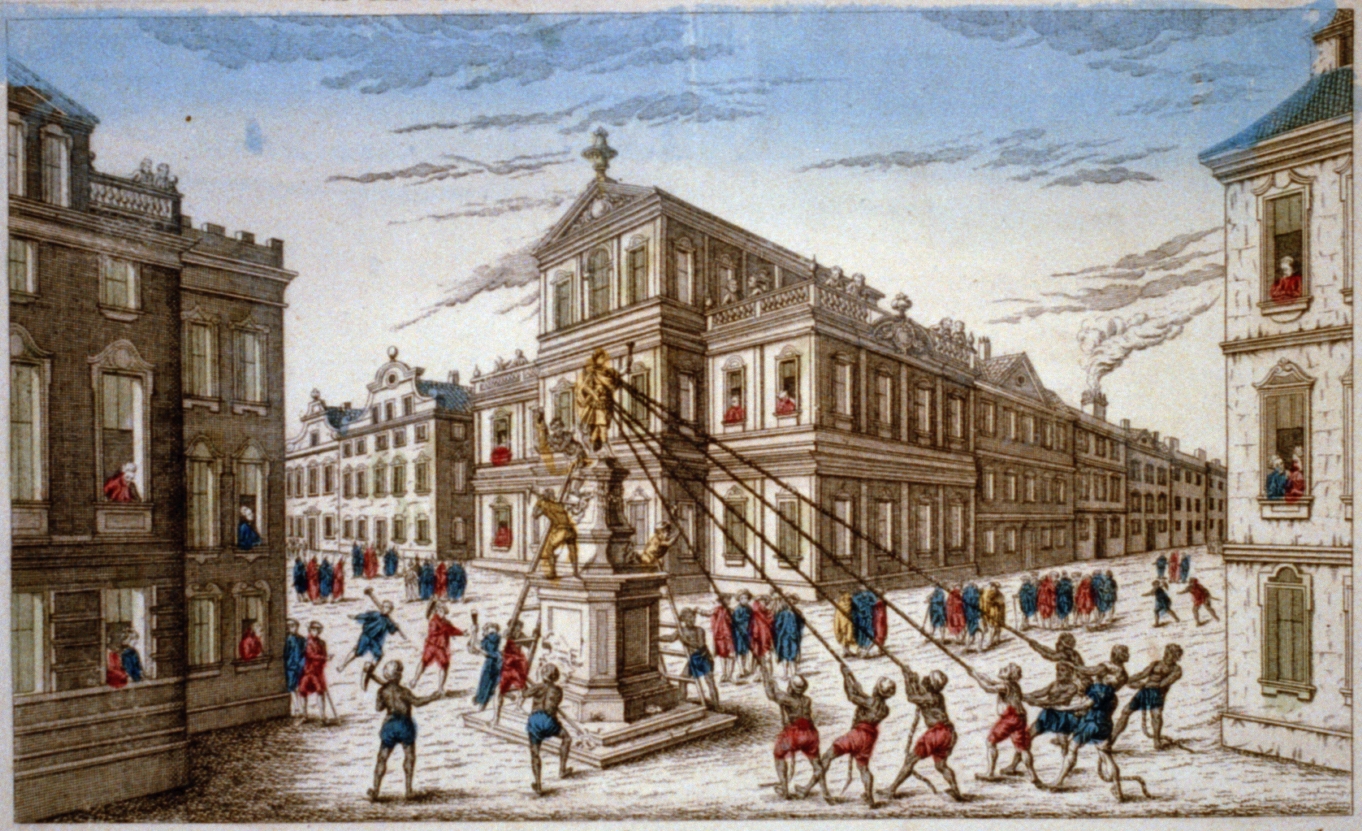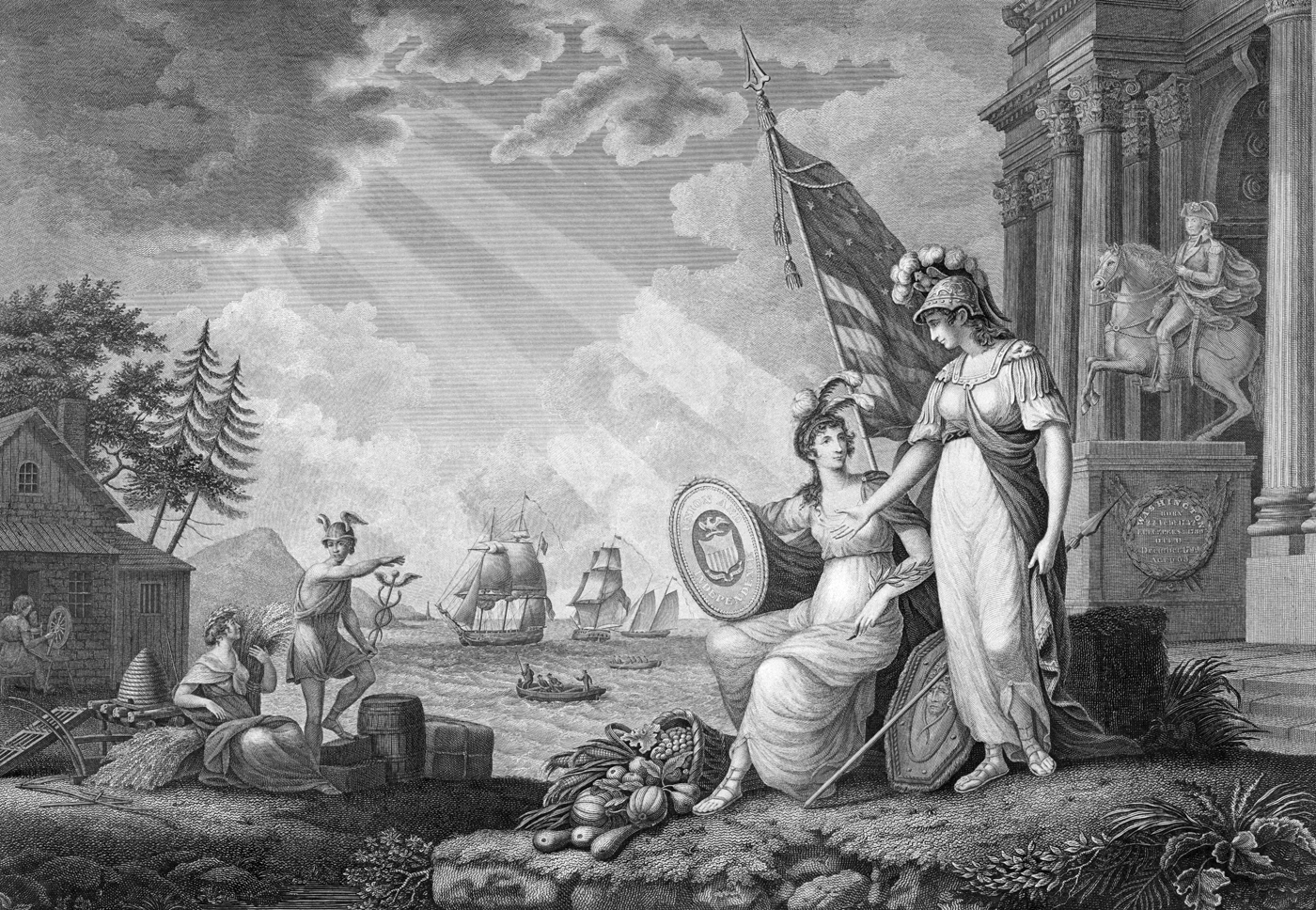Chapter 6 A New Republic: 1750–1830
1750–1830
“We hold these truths to be self-evident, that all men are created equal, that they are endowed by their Creator with certain unalienable Rights, that among these are Life, Liberty and the pursuit of Happiness.” With these words, on July 4, 1776, the United States of America declared its independence from England, and our nation was born. Commissioned by the Continental Congress and written by Thomas Jefferson with help from John Adams and Benjamin Franklin, the Declaration of Independence was first published as a broadside—a large sheet of paper meant for mass distribution—and distributed throughout the colonies to be read aloud. At once a rallying cry against oppression and tyranny and, according to Jefferson, an “expression of the American mind,” the Declaration of Independence, one of the documents you will read in this chapter, still strikes a chord in us almost two and a half centuries later. Now, of course, we read the document as much more than simply a declaration of our independence; it is at once an extraordinary statement on human rights, moral principles, and the right to revolt and also an essential piece of American literature.
Revolutionary sentiment had been brewing in the colonies for a decade and a half prior to the declaration, articulated by writers and thinkers such as Patrick Henry and Thomas Paine, who built the moral and intellectual case for revolution and for the war that it would cause. John Adams would later reflect, “But what do we mean by the American Revolution? Do we mean the American War? The Revolution was effected before the War commenced. The Revolution was in the minds and hearts of the people; a change in their religious sentiments, of their duties and obligations…this radical change in the principles, opinions, sentiments, and affections of the people, was the real American Revolution.”
But the war would surely come. As King George III issued taxes that placed financial burdens on the colonists and passed laws that limited their freedoms, the rallying cry “no taxation without representation” spread throughout the colonies. The Boston Massacre of 1770, in which British soldiers fired into a crowd of protestors and killed five civilians, further strained Britain’s relationship with the colonies. Three years later, colonial resistance culminated in the Boston Tea Party. The destruction of three shiploads of taxed tea was a pivotal moment in the run-up to what we now call the Revolutionary War, triggering more protests against the British and leading to the First Continental Congress. It was still another five years before the first military actions of the war began at the battles of Lexington and Concord on April 19, 1775; its first shot was immortalized in Ralph Waldo Emerson’s poem “Concord Hymn” as “the shot heard round the world.” Paine’s Common Sense of January 1776 and Crisis pamphlets that followed, perhaps more than any other documents, helped American soldiers find the strength necessary to maintain the fight.


The Revolutionary War lasted until 1781, when the British finally surrendered to colonial forces at Yorktown, and officially concluded with the signing of the Treaty of Paris in 1783, but internal struggles persisted. Independence did not necessarily guarantee equitable and just governance. The declaration promised life, liberty, and the pursuit of happiness, but it would be up to the colonists whom we now call the Founding Fathers to secure those promises. What, precisely, would the new government be like? How should states be represented? And how much power would fall to the federal government rather than to the states? In their famous Federalist papers, published under the name Publius, Alexander Hamilton, James Madison, and John Jay argued for the Federalist cause and for the adoption of the Constitution. Anti-Federalists were concerned with the primacy of states’ rights; most prominent among them, Samuel Adams of Massachusetts and Patrick Henry of Virginia, feared that the Constitution would grant the central government too much power. And now, well over two centuries later, we find that such debates continue.
The Constitution called for a president to head the executive branch of government and be the commander in chief of the armed forces. The nation chose not Thomas Jefferson or Benjamin Franklin but the war hero General George Washington, perhaps the ideal candidate to assume the role of first president. Equally powerful as a man and a myth, he embodied the American ideals of strength and courage, both physical and moral. This chapter includes a group of texts that explore how the myth of George Washington was created and how it continues to be part of our national identity.
The authors of our founding documents were children of the Enlightenment, influenced by the philosophical and scientific ideas of such thinkers and “natural philosophers” (the word scientist would not be used until 1833) as Isaac Newton and John Locke. Many of the Founding Fathers (two notable exceptions being the aforementioned Patrick Henry and Samuel Adams) were “Deists,” rationalists who looked to the world itself rather than to scripture for an understanding of God and the universe. More concerned with tolerance than with orthodoxy, they enshrined religious tolerance in the Constitution by writing “Congress shall make no law respecting an establishment of religion, or prohibiting the free exercise thereof.” America was, and is, a very religious nation. Most Americans at the time read little more than the Bible. And even if most of the Founding Fathers were Deists, that doesn’t mean the population was. This chapter includes a Conversation that will ask you to compare the ideal of religious tolerance with the reality.
Once the revolution was accomplished, the Constitution ratified, and a president chosen, the citizens of the new nation began forging a new identity. What did it mean to be an American? That is the question addressed by Hector St. John de Crèvecoeur in his 1782 Letters from an American Farmer. Looking at America, Crèvecoeur saw a new land where a diverse population lived in freedom and equality, fulfilling the promise of Jefferson’s declaration.
America was a new kind of nation where “all men are equally citizens.” But what does “men” mean in the declaration? Clearly it does not mean “mankind,” since that would include women. Nor did it refer to black men, most of whom were slaves, or to Native Americans. By 1804, the Northern states had abolished slavery, and by 1808 our third president, Thomas Jefferson, had outlawed the importation of slaves. But these measures didn’t guarantee equality. Thus America, founded on the notion of equality, paradoxically remained a nation of inequality. In this chapter, this paradox is addressed by such writers as Judith Sargent Murray, who addressed women’s rights as early as 1790; by Benjamin Banneker, who wrote to Thomas Jefferson about slavery in 1791; and by Chief Red Jacket and Chief Tecumseh, who addressed Native American rights in the first decade of the 1800s. Some scholars would add Phillis Wheatley to this list of dissenters. The first African American woman to publish a book, her political and poetic legacy continues to be the subject of debate, one that you will enter in this chapter’s Conversation on the influence of Phillis Wheatley, in which you will consider such questions as these: Did she embed subtle protests against slavery in her poetry? Should she have called for freedom more forcefully? Did her poetry change the way early Americans thought of African Americans?
As America moved into the nineteenth century, it saw a period of unprecedented growth. The Louisiana Purchase of 1803 doubled the size of the country, and by 1830 the nation had increased from the original thirteen colonies to twenty-four states (half slave states and half free) with a population of over 12 million people, including nearly 2 million slaves. In addition, there were over 100,000 native Indians residing in the states, 50,000 Indians having been “removed” to Indian Territory. As the nation grew, so too did the ideological rifts—Federalism versus states’ rights, freedom versus slavery, American ideals versus reality—that would threaten the very truths proclaimed in the Declaration of Independence. The literature in this chapter shows a new nation struggling with those rifts, one struggling to fulfill the promise of its birth.

This allegorical image uses classical allusions to express optimism in the American democratic experiment. The artists described the image as follows: “On the fore ground Minerva, the goddess of Wisdom, is pointing to a Shield, supported by the Genius of America, bearing the Arms of the United States, with the motto UNION AND INDEPENDENCE, by which the country enjoys the prosperity signaled by the horn of plenty at the feet of America. The second ground is occupied by an Equestrian Statue of WASHINGTON placed in front, indicating the progress of the liberal arts. Commerce is represented by the FIGURE of Mercury, with one foot resting on bales of American manufactures, pointing out the advantages of encouraging and protecting Navigation, signified by an armed vessel under sail, to Ceres, who is seated with implements of Agriculture near her. The Bee Hive is emblematic of industry, and the female spinning at the cottage door, shows the first and most useful of domestic manufactures.”